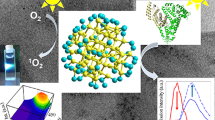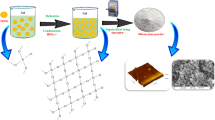Abstract
The effects of crystalline silicon (Si) nanoparticles covered with gold and silver on the viability and state of cellular organelles of cultured human peripheral blood lymphocytes were investigated. After interaction with Si nanoparticles covered with gold (Si/Au) or with silver (Si/Ag), the reactive oxygen species in cells increased, but their viability was not decreased. The Si/Au nanoparticles decreased functional activity of lysosomes and mitochondria, while Si/Ag decreased the functional activity only of mitochondria. It is concluded that modification of a surface with gold or silver results in a reduction of biocompatibility of crystalline silicon nanoparticles.
Similar content being viewed by others
Abbreviations
- ROS:
-
reactive oxygen species
- NP:
-
nanoparticles
- MIF:
-
mean intensity of fluorescence
References
Asharani, P.V., Mun, G.L.K., Hande, M.P., and Valiyaveettil, S., Cytotoxicity and genotoxicity of silver, ACS Nano, 2009, vol. 3, pp. 279–290.
Baltazar, G.C., Guha, S., Lu, W., Lim. J., Boesze-Battaglia, K., Laties, A.M., Tyagi, P., Kompella, U.B., and Mitchell, C.H., Acidic nanoparticles are trafficked to lysosomes and restore an acidic lysosomal pH and degradative function to compromised ARPE-19 cells, PloS One, 2012, vol. 7, pp. 1–10.
Bhattacharjee, S., Hann, L., Evers, N.M., Jiang, X., Marcelis, A.T., Zuilhof, H., Rietjens, I.MCM., and Alink, G., Role of surface charge and oxidative stress in cytotoxicity of organic monolayer-coated silicon nanoparticles towards macrophage NR8383 cells, Particle Fibre Toxicol., 2010, vol. 7, pp. 1–12.
Braydich-Stolle, L., Hussain, S., Schlager, J.J., and Hofmann, M., In vitro cytotoxicity of nanoparticles in mammalian germline stem cells, Toxicol. Sci., 2005, vol. 88, pp. 412–419.
Canham, L.T., Nanoscale semiconducting silicon as a nutritional food additive, Nanotechnology, 2007, vol. 18, pp. 1–6.
Choi, J., Zheng, Q., Katz, H.E., and Guilarte, T.R., Silica-based nanoparticle uptake and cellular response by primary microglia, Environ. Health Persp., 2010, vol. 118, pp. 589–595.
Dyrnev, A.D., Solomina, A.S., Daugel-Dauge, N.O., Ganataev, A.K., Shreader, E.D., Nemova, E.P., Shreader, O.V., Veligura, V.A. Osminkina, L.A., Timoshenko, V.Yu., and Seredenin, S.B., Investigation of genotoxic and teratogenic activity of silicon nanocrystals, Bull. Exp. Biol. Med., 2010, vol. 149, no. 4, pp. 429–443.
Fujoka, K., Hanada, S., Kanaya, F., Hoshino, A., Sato, K., Yokosuka, S., Takigami, Y., Hirakuri, K., Shiohara, A., Tilley, R.D., Manabe, N., Yamamoto, K., and Manome, Y., Toxicity test: fluorescent silicon nanoparticles, J. Physics: Conf. Series., 2011, vol. 304, pp. 1–5.
Halamoda Kenzaoui, B., Chapuis Bernasconi, C., Guney-Ayra, S., and Juillerat-Jeanneret, L., Induction of oxidative stress, lysosome activation and autophagy by nanoparticles in human brain-derived endothelial cells, Biochem. J., 2012, vol. 441, pp. 813–821.
Huang, X., Jain, K.P., El-Sayed, I.H., and El-Sayed, M.A., Plasmonic photothermal therapy (PPTT) using gold nanoparticles, Lasers Med. Sci., 2008, vol. 23, pp. 217–228.
Ipe, B.I., Lehnig, M., and Niemeyer, C.M., On the generation of free radical species from quantum dots, Small, 2005, vol. 1, pp. 706–709.
Iskusnykh, I.Y., Popov, A.L., Popova, T.N., Kashkarov, V.M., and Tsipenyuk, V.N., Effect of nanocrystalline silicon for biological activity and fibroblast proliferation and laryngeal carcinoma cells, Vestnik VGU, 2012, vol. 1, pp. 96–102.
Lee, J.S., Seferos, D.S., Giljohann, D.A., and Mirkin, C.A., Thermodynamically controlled separation of polyvalent 2-nm gold nanoparticle-oligonucleotide conjugates, J. Am. Chem. Soc., 2008, vol. 130, pp. 5430–5431.
Li, W., Zhao, L., Wei, T., Zhao, Y., and Chen, C., The inhibition of death receptor mediated apoptosis through lysosome stabilization following internalization of carboxyfullerene nanoparticles, Biomaterials, 2011, vol. 32, pp. 4030–4041.
Lin, W., Huang, Y., Zhou, X., and Ma, Y., In vitro toxicity of silica nanoparticles in human lung cancer cells, Toxic. Appl. Pharm., 2006, vol. 217, pp. 252–259.
Lu, J., Liong, M., Li, Z., Zink, J.I., and Tamanoi, F., Biocompatibility, biodistribution, and drug-delivery efficiency of mesoporous silica nanoparticles for cancer therapy in animals, Small, 2011, vol. 6, pp. 1794–1805.
Moore, M.N., Readman, J.A.J., Readman, J.W., Lowe, D.M., Frickers, P.E., and Beesley, A., Lysosomal cytotoxicity of carbon nanoparticles in cells of the molluscan immune system: an in vitro study, Nanotoxicology, 2009, vol. 3, pp. 40–45.
Oloffs, A., Grosse-Siestrup, C., Bisson, S., Rinck, M., Rudolph, R., and Gross, U., Biocompatibility of silvercoated polyurethane catheters and silver-coated dacron material, Biomaterials, 1994, vol. 15, pp. 753–758.
Osminkina, L.A., Gongalsky, M.B., Timoshenko, V.Yu., and Kudryavtsev, A.A., Silicon nanoparticles as effective sonosensitizer for treatment in oncological patients, Onkokhirurgiya, 2011, vol. 3, no. 1, pp. 34–36.
Panyam, J., Zhou, W., Prabha, S., Sahoo, S.K., and Labhasetwar, V., Rapid endo-lysosomal escape of poly(DL-lactide-co-glycolide) nanoparticles: implications for drug and gene delivery, FASEB J., 2002, vol. 16, pp. 1217–1226.
Shubenkov, A.N., Korovin, S.B., Andreeva, E.R., Buravkova, L.B., and Pustovoy, V.I., In vitro evaluation of silicon nanoparticles cytotoxicity, Biofizika, 2014, vol. 59, no. 1, pp. 134–139.
Sohaebuddin, S.K., Thevenot, P.T., Baker, D., Eaton, J.W., and Tang, L., Nanomaterial cytotoxicity is composition, size, and cell type dependent, Particle Fibre Toxicol., 2010, vol. 7, pp. 1–17.
Stern, S.T., Adiseshaiah, P.P., and Crist, R.M., Autophagy and lysosomal dysfunction as emerging mechanisms of nanomaterial toxicity, Particle Fibre Toxicol., 2012, vol. 9, pp. 1–15.
Thibodeau, M.S., Giardina, C., Knecht, D.A., Helble, J., and Hubbard, A.K., Silica-induced apoptosis in mouse alveolar macrophages is initiated by lysosomal enzyme activity, Toxicol. Sci., 2004, vol. 80, pp. 34–48.
Timoshenko, V.Yu., Kudryavtsev, A.A., Osminkina, L.A., Vorontsov, A.S., Ryabchikov, Yu.V., Belogorokhov, I.A., Kovalev, D.V., and Kashkarov, P.K., Silicon nanocrystals as photosensitizers of active oxygen for biomedical applications, Pis’ma ZhETF, 2006, vol. 83, no. 9, pp. 492–495.
Vladimirov, A., Korovin, S., Surkov, A., Kelm, E., and Pustovoy, V., Synthesis of luminescent Si nanoparticles using the laser-induced pyrolysis, Laser Physics, 2011, vol. 21, pp. 830–835.
Xia, T., Kovochich, M., Brant, J., Hotze, M., Sempf, J., Oberley, T., Sioutas, C., Yeh, J.I., Wiesner, M.R., and Nel, A.E., Comparison of the abilities of ambient and manufactured nanoparticles to induce cellular toxicity according to an oxidative stress paradigm, Nano Letters, 2006, vol. 6, pp. 1794–1807.
Xia, T., Kovochich, M., Liong, M., Madler, L., Gilbert, B., and Shi, H., Comparison of the mechanism of toxicity of zinc oxide and cerium oxide nanoparticles based on dissolution and oxidative stress properties, ACS Nano, 2008, vol. 2, pp. 2121–2134.
Author information
Authors and Affiliations
Corresponding author
Additional information
Original Russian Text © A.N. Shubenkov, S.B. Korovin, E.R. Andreeva, L.B. Buravkova, V.I. Pustovoy, 2014, published in Tsitologiya, 2014, Vol. 56, No. 7, pp. 511–515.
Rights and permissions
About this article
Cite this article
Shubenkov, A.N., Korovin, S.B., Andreeva, E.R. et al. Modification of silicon nanoparticle surface with gold or silver attenuates its biocompatibility in vitro. Cell Tiss. Biol. 8, 384–388 (2014). https://doi.org/10.1134/S1990519X14050083
Received:
Published:
Issue Date:
DOI: https://doi.org/10.1134/S1990519X14050083




